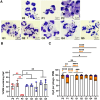Effects of the pan-caspase inhibitor Q-VD-OPh on human neutrophil lifespan and function
- PMID: 39775346
- PMCID: PMC11706505
- DOI: 10.1371/journal.pone.0316912
Effects of the pan-caspase inhibitor Q-VD-OPh on human neutrophil lifespan and function
Abstract
Human neutrophils are abundant, short-lived leukocytes that turn over at a rate of approximately 1011 cells/day via a constitutive apoptosis program. Certain growth factors, inflammatory mediators and infectious agents can delay apoptosis or induce neutrophils to die by other mechanisms. Nonetheless, a large body of data demonstrates that apoptosis of untreated neutrophils typically ensues within 24 hours of cell isolation and in vitro culture. At the molecular level apoptosis is driven by executioner caspase-3, and during this process cell proinflammatory capacity and host defense functions are downregulated. We undertook the current study to determine the extent to which human neutrophil viability and function could be prolonged by treatment with the non-toxic, irreversible, pan-caspase inhibitor Q-VD-OPh. Our data demonstrate that a single 10 μM dose of this drug was sufficient to markedly prolong cell lifespan. Specifically, we show that apoptosis was prevented for at least 5 days as indicated by analysis of nuclear morphology, DNA fragmentation, and phosphatidylserine externalization together with measurements of procaspase-3 processing and caspase activity. Conversely, mitochondrial depolarization declined despite abundant Myeloid Cell Leukemia 1 (MCL-1). At the same time, glutathione levels were maintained and Q-VD-OPh prevented age-associated increases mitochondrial oxidative stress. Regarding functional capacity, we show that phagocytosis, NADPH oxidase activity, chemotaxis, and degranulation were maintained following Q-VD-OPh treatment, albeit to somewhat different extents. Thus, a single 10 μM dose of Q-VD-OPh can sustain human neutrophil viability and function for at least 5 days.
Copyright: © 2025 Khuu et al. This is an open access article distributed under the terms of the Creative Commons Attribution License, which permits unrestricted use, distribution, and reproduction in any medium, provided the original author and source are credited.
Conflict of interest statement
The authors have declared that no competing interests exist.
Figures







Similar articles
-
Dose-dependent effects of the caspase inhibitor Q-VD-OPh on different apoptosis-related processes.J Cell Biochem. 2011 Nov;112(11):3334-42. doi: 10.1002/jcb.23263. J Cell Biochem. 2011. PMID: 21751237
-
Flavones induce neutrophil apoptosis by down-regulation of Mcl-1 via a proteasomal-dependent pathway.FASEB J. 2013 Mar;27(3):1084-94. doi: 10.1096/fj.12-218990. Epub 2012 Nov 29. FASEB J. 2013. PMID: 23195034 Free PMC article. Clinical Trial.
-
Sarin-Induced Neuroinflammation in Mouse Brain Is Attenuated by the Caspase Inhibitor Q-VD-OPh.J Pharmacol Exp Ther. 2024 Jan 17;388(2):367-375. doi: 10.1124/jpet.123.001820. J Pharmacol Exp Ther. 2024. PMID: 37918856 Free PMC article.
-
Inhibition of Apoptosis and Efficacy of Pan Caspase Inhibitor, Q-VD-OPh, in Models of Human Disease.J Cell Death. 2015 Apr 8;8:1-7. doi: 10.4137/JCD.S23844. eCollection 2015. J Cell Death. 2015. PMID: 25922583 Free PMC article. Review.
-
Regulation of neutrophil survival/apoptosis by Mcl-1.ScientificWorldJournal. 2011;11:1948-62. doi: 10.1100/2011/131539. Epub 2011 Oct 26. ScientificWorldJournal. 2011. PMID: 22125448 Free PMC article. Review.
References
MeSH terms
Substances
LinkOut - more resources
Full Text Sources
Research Materials

